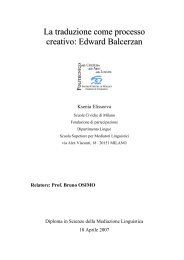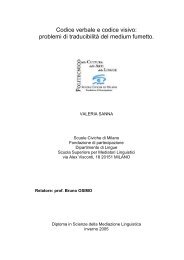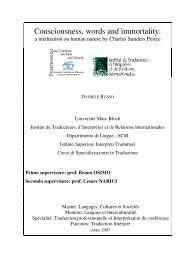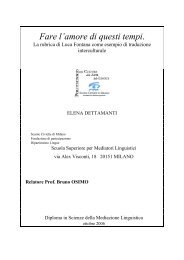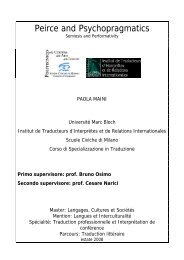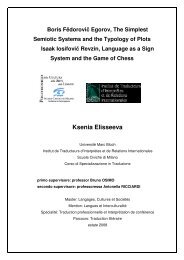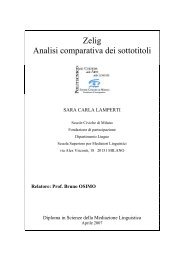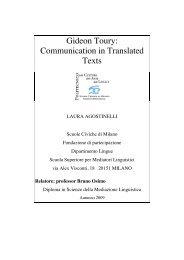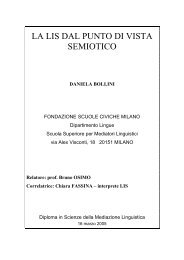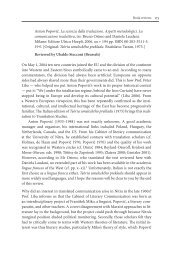A Semiotic Approach to the Theory of Translation: - Bruno Osimo ...
A Semiotic Approach to the Theory of Translation: - Bruno Osimo ...
A Semiotic Approach to the Theory of Translation: - Bruno Osimo ...
Create successful ePaper yourself
Turn your PDF publications into a flip-book with our unique Google optimized e-Paper software.
The <strong>Semiotic</strong> Concept<br />
All <strong>the</strong> modern <strong>the</strong>oreticians describe only L N → L N ’, and so<br />
have I up <strong>to</strong> this point. But present-day practice shows us<br />
translation between artificial languages (L A → L A ’). Hence we<br />
must ask ourselves: Is translation limited <strong>to</strong> L N , or is it much<br />
wider in scope It is <strong>the</strong> analysis <strong>of</strong> this question which has led<br />
me <strong>to</strong> <strong>the</strong> semiotic concept <strong>of</strong> translation.<br />
First, however, it is necessary <strong>to</strong> point out that although<br />
general semiotic <strong>the</strong>ory has introduced many very abstract<br />
notions, e.g., ‘sign’, ‘sign-system’ (=code), ‘information’,<br />
‘message’; it does not provide <strong>the</strong> concept <strong>of</strong> semiotic<br />
transformation, though such transformations certainly exist. This<br />
gap in <strong>the</strong> elements <strong>of</strong> our <strong>the</strong>oretical apparatus needs <strong>to</strong> be<br />
filled.<br />
To that end I have analysed many information processes, e.g.,<br />
sending a cable, visual perception, hearing aids, decimal <strong>to</strong><br />
binary notation, passage from deep <strong>to</strong> surface linguistic<br />
structures, <strong>the</strong> genetic code, human memory, ma<strong>the</strong>matical<br />
transcriptions, etc. Some <strong>of</strong> <strong>the</strong>m are relatively simple: for<br />
instance sending a telegram, where a message M coded in L N is<br />
transformed symbolically in<strong>to</strong> a message M’ in universal<br />
(‘International’) Morse code, and <strong>the</strong> transformation would be<br />
utterly useless if a constant information I were not preserved.<br />
O<strong>the</strong>r examples are much more complex, but lead me <strong>to</strong> <strong>the</strong><br />
same general conclusion:<br />
29



